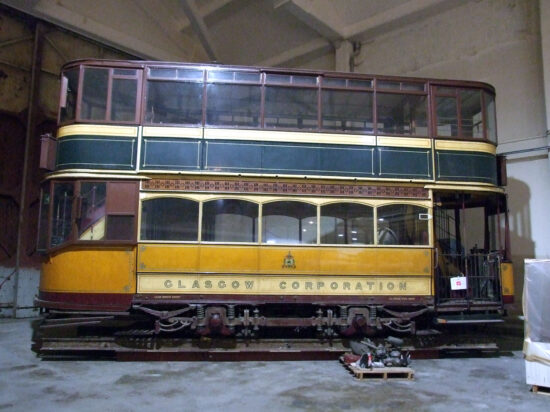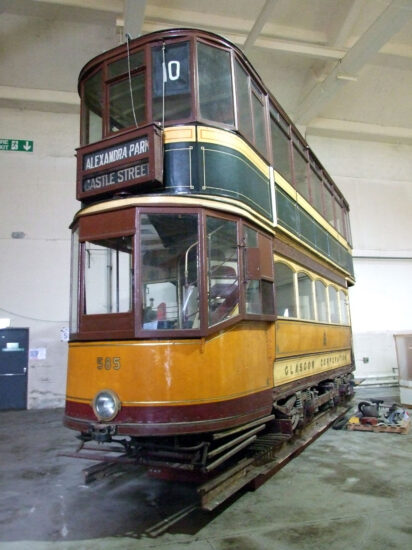Whilst there are many Glasgow trams which have been preserved there is probably one which has proved to be elusive to most – Glasgow 585. Owned by the Science Museum the tram used to be on display at the Kensington based museum (until the late 1990s) but has more recently been kept in their off-site storage in Wiltshire. With no public access to the Wroughton store for some time the tram has remained out of sight but when volunteers from the Ipswich Transport Museum went to collect an Ipswich trolleybus which was being transferred east they couldn’t resist the chance to record the Standard car in photographic form.
Glasgow 585 was built in May 1901 as an open topper before receiving a short top cover (the condition that 22 operates in at Crich) and then in 1930 it was rebuilt to a fully enclosed tram. Withdrawn in October 1961, 585 was restored to its 1930s condition and received a repaint into the Blue route livery.
Purchased by a private individual the tram was originally due to head to the scheme at the Middleton Railway but, and probably fortunately, it never made the trip to Leeds when it became clear the project was not going to get off the ground. November 1962 then saw it leave Glasgow for the Science Museum with ownership having been transferred to that organsation.
It remained on display at the Science Museum until the late 1990s but a reorganisation of exhibits a that time saw the decision made to transfer 585 off-site and that is when it made the trip to Wroughton in Wiltshire for storage. Now over 20 years later and that is where the tram remains, in safe undercover storage but away from the public eye.
There are ambitious plans to develop the site at Wroughton – which is located at a former RAF airfield – to create a new, publicly accessible home for over 300,000 items from the Science Museum collection. To be known as the National Collections Centre the new facility should be open from 2024 with it being opened regularly for public tours, school and research visits. What part 585 may play in these though is unknown.
The reason for these rare photos of 585 being taken was the transfer of Ipswich trolleybus 44 to the Ipswich Transport Museum. Formerly owned by the Science Museum it has now been donated to the Ipswich Transport Museum and will go on display and be restored at the museum. It arrived back in its home town on 22nd April 2022.



It’s looking its age, sadly.
She’s a lovely old lady.
What chance that she might just be restored to run again somewhere?
After all, her sister, 488, is showing the way.
I’d say 488 is the reason it won’t get restored and they have always said they want to preserve its originality and restoration would destroy that.
So many good trams are in store and can rarely be seen. It is always worrying that at some point their owners may decide that they can’t afford the space, nobody sees them anyway and then they are got rid of, even scrapped. Things sequestered away in store always posit the question ‘what are they keeping them for?’, and when this question arises among museum management, then ‘deaccessioning’ is a way to rid themselves of unwanted items, as with the Ipswich trolleybus, and several steam locomotives from the National Railway Museum in York. Deliberate get-out clauses in the legal status of national collections means that nothing in a museum needs to be ‘kept for the Nation’ if the authorities deem it to be surplus to requirements.
Deaccessioning (if done correctly) should follow some simple but strict rules. My understanding is the rules are as follows, but please feel free to correct me if this is not the case.
For example, if a museum wanted to get rid of a tram it must first be offered to other museums. If there is no interest, it can then be offered to other organisations, then offered for sale privately. Only if there is still no interest can it then be sold or broken up for spares or scrap. For this reason museums sometimes don’t accession items they receive in the first place.
A properly run museum should have a register of accessioned items and the items’s accession number should be marked somewhere on the object. The register should have details of what the item is, where it came from and any details of what happened to it if it has since been disposed of. For items as small as a coin or as big as an aeroplane, the rules are exactly the same.
I find it odd really that we don’t get more comments about the ‘plight’ of this tram; we often see people moaning about the British trams that are in America in a poor state, yet one like this would surely be easier to rescue. That said, there are quite a few Glasgow Standard cars around and as John rightly says, 488’s restoration will probably weaken the case for doing anything with 585.
I’m grateful to colleagues for the detail outlined above, and there’s the feeling that we’re singing from the same hymn sheet.
While I agree that there are Glasgow Standards preserved and some running, this fact shouldn’t allow us to close our eyes to the fact that 585 remains in deep freeze.
There isn’t a Glasgow Standard running in Scotland (yet), and there is the growing and welcome number of re-created tramways around the UK. Is another Glasgow Standard really going to over-egg the pudding? I hope not.
I wonder if having a new curator at the Science Museum will make any difference to their policy on vehicles going to good homes as in the cases of Gilford GW 713 and Ipswich trolleybus 44?